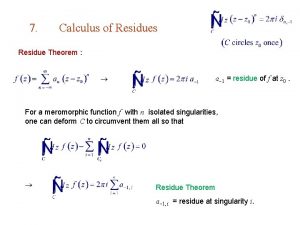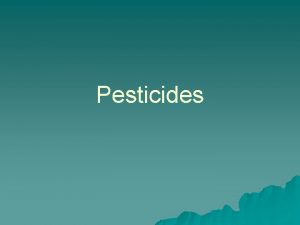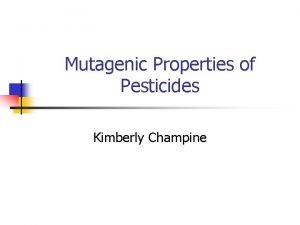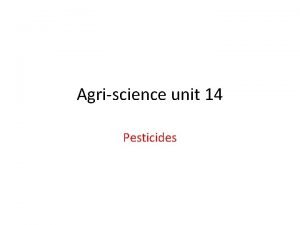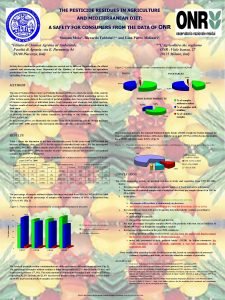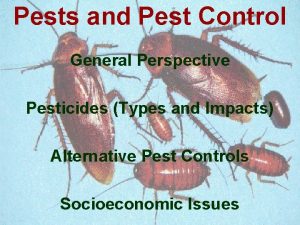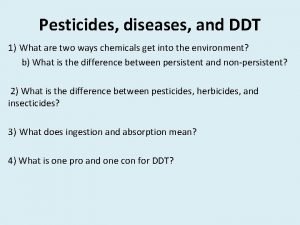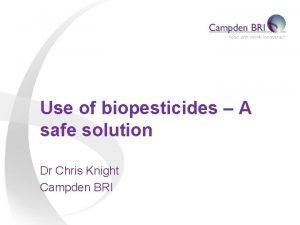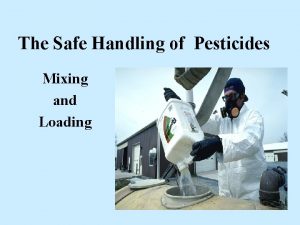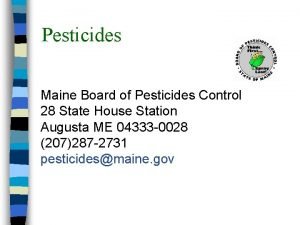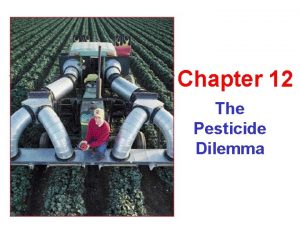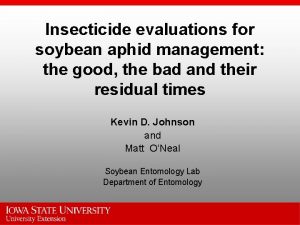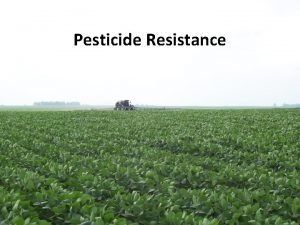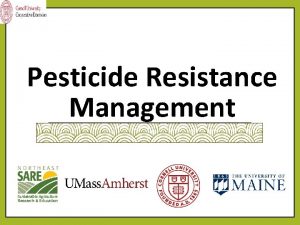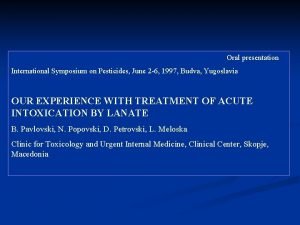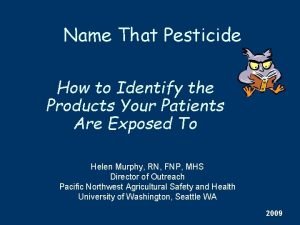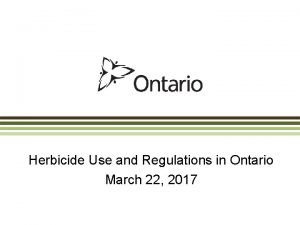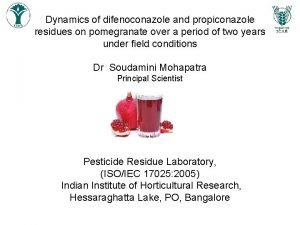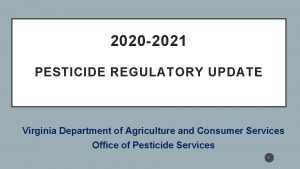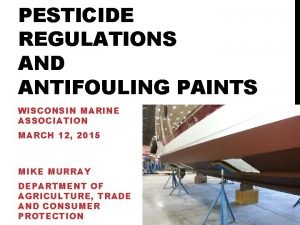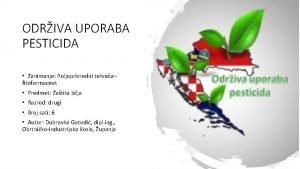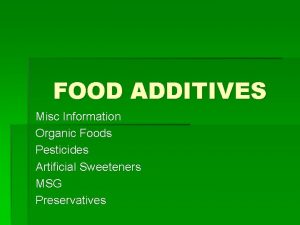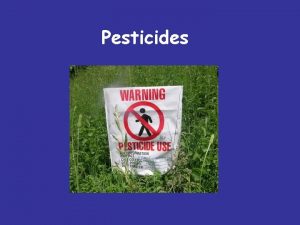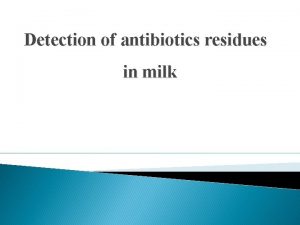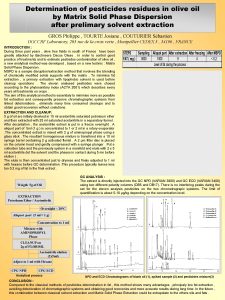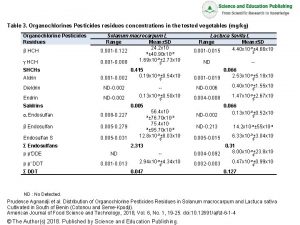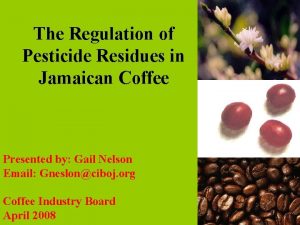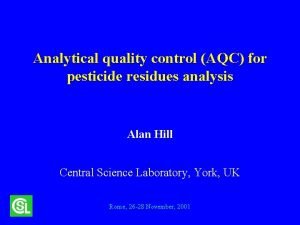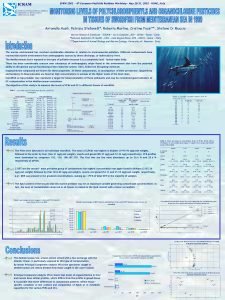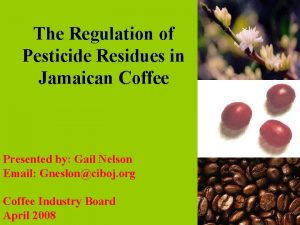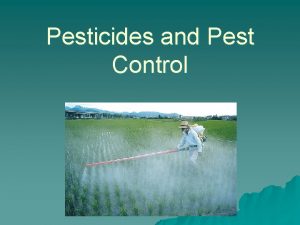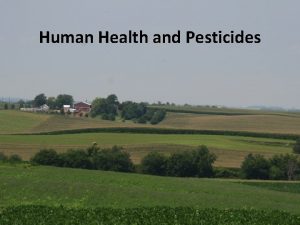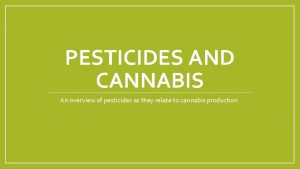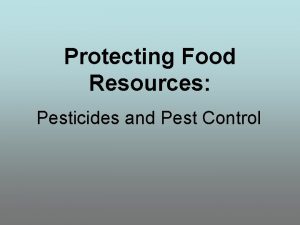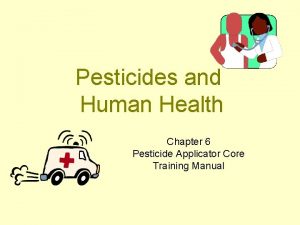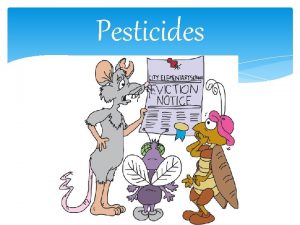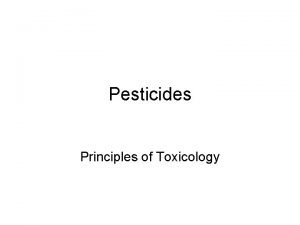PESTICIDE RESIDUES Fears and Facts What are Pesticides
































- Slides: 32

PESTICIDE RESIDUES Fears and Facts

What are Pesticides? § Pesticide are chemical or biological substances that are used to kill or control pests that harm our crops, food, health or environments. § Pests include rodents, insects, fungi and weeds, and they cause enormous damage to the crops. Insects like mosquitoes carry and spread diseases like Malaria, Dengue and Chickungunya.

What are Pesticide Residues? • Pesticide residues are very small amounts of pesticides or their breakdown products that can remain in a crop after harvesting or storage and make their way into the food chain.

What are the causes of Pesticide Residues? § Persistent nature of Pesticides § Contamination of water and soil § Direct application of Pesticides during storage § Improper dosage and timings of pesticide application

Dose decides the toxicity • A pesticide or a chemical can’t simply be classified as “dangerous” or “safe” : it always depends on the amount or dose, used. • The effects of a pesticide or chemical or its residue will change with different amounts used. • The levels of residues are also expressed as µg-1 “parts per million” (ppm) or “parts per billon” (ppb). • A ppb is roughly equal to 1 second in a life-span of 30 years.

The dose effect • As Aspirin tablet is good to reduce headache or pain, whereas 50 tablets could cause acute renal failure, coma, and heart failure from salicylate poisoning. • Botulinus toxin (botox) is one of the most powerful poisons we know; its use in ‘cosmetics’ is safe, only because of careful localization. What might kill, you if put into your stomach, can erase your worry-lines. (Sir Colin Berry, Pathologist)


§Export of the agricultural commodities particularly of fruits and vegetables is on the increase. Even advanced nations in Europe who have very stringent regulations of pesticides use, have found Indian fruits safe, as pesticide residues are well within the permitted levels.

What is MRL (maximum Residual Limits)? • MRL is the maximum concentration of a possible residue on crop or food commodity resulting from the use of pesticides and is expressed in mg/kg of the commodity.

What is ADI ( Acceptable Daily Intake)? q This is an estimate of the amount of a chemical in food that can be ingested daily over a lifetime by humans without appreciable health risk. q. The concept of the ADI has been developed principally by WHO and FAO for additives to foodstuffs, residues of pesticides and veterinary drugs in foods.

Is there a health risk if residues in food are greater than MRL? • The MRL is not a health-based exposure limit. • Exposure to residues in excess of an MRL does not necessarily imply a risk to health. • MRL is not in itself a safety level and is always set at levels well below those, which would cause potential risks. Therefore the residues. If present below the approved MRLs, are harmless. • MRLs are set 100 times below ADI (Acceptable Daily Intake)

Do pesticide residues degrade? • Most pesticides break down with exposure to the weather elements. • Microbial activity in the plant, soil and environment also reduces or eliminates residues. • In the process of cleaning, peeling and cooking of vegetables, fruits and food grains most pesticide residues are removed and broken-up. • The process of digestion and blood cleansing also removes the residues from our body.

EPILOGUE o Safe, judicious and technically correct use of pesticides has to be promoted amongst farmers to reduce the 30 to 50% crop losses. o As long as we use pesticides to control pests and prevent the crop losses, pesticide residues in food is a fact of life. But they are no cause for concern, if the required pesticide is used as directed in the label.

What is the status of fixing MRL for various pesticides registered in India? Number of pesticides in India registered in India 194 Pesticides for which MRLs have been fixed under PFA act, 1954 71 Pesticide for which MRLs yet to be fixed 21 Pesticides for which registration data has been submitted but MRLs not Fixed 36 Pesticides for which no data is available 08

As per direction of the Delhi High Court, the annual report 2014 -15 of MPR NL has been uploaded to the DAC website. The status of pesticide residues in food commodities during 2008 -15 are as follows: Year Number of samples analysed Number of samples above MRL 13348 Number of samples detected with residues N/A 2008 -09 2009 -10 14225 N/A 147 (1. 0 %) 2010 -11 15321 N/A 154 (1. 0%) 2011 -12 16948 N/A 270 (1. 6%) 2012 -13 16494 N/A 403 (2. 4 %) 2013 -14 16660 2759 (16. 6%) 458 (2. 7%) 2014 -15 20618 3857 (18. 7%) 543 (2. 6%) 183 (1. 4 %)

India: Year Samples analysed Samples with Detection Above MRL 2008 -09 6031 714 (11. 8 %) 137(2. 3 %) 2009 -10 6353 604 (9. 5 %) 102(1. 6 %) 2010 -11 7232 738 (10. 2 %) 140 (1. 8 %) 2011 -12 8611 1219 (14. 1 %) 220 (2. 5 %) 2012 -13 9601 1630 (16. 9 %) 255 (2. 6 %) 2013 -14 9772 1809 (18. 5%) 260 (2. 7%) 2014 -15 12832 2674 (20. 8%) 346 (2. 7%) Source: http: //www. fda. gov/Foodborne. Illness. Contaminants/Pesticides/ucm 2006797. htm

United States Food and Drug Administration (US-FDA): Year Samples analysed 2008 -09 1046 Samples with Detection 431 (41. 2 %) Above MRL 2009 -10 1173 614 (52. 3 %) 16 (2 %) 2010 -11 1220 472 (38 %) 26 (2. 1 %) 2011 -12 797 353 (44. 2 %) 17 (2. 1 %) 2012 -13 1906 872 (45. 8%) 66 (3. 5%) 12 (1. 1 %)

United Kingdom(UK): Year Samples with analysed Detection Above MRL 2008 -09 2309 1484 (64. 3 %) 49 (2. 1 %) 2009 -10 1848 1105 (59. 8 %) 40 (2. 2 %)



Crop losses due to pests • 50% of total production is last due to insect, pests, plant pathogens, weeds rodents, birds, nematodes and in storage.

Estimation crop losses Rs. 90, 000 corers (Crops 29240, fruit/ vegetable 30, 000, storage 30, 000 • Production of pesticide year 1950 1994 2003 -04 2004 -05 2005 -06 2006 -07 2007 -08 2008 -09 MT 2000 85000 37352 38276 82240 84999 83423 85338

Consumption Pattern of pesticides Country Korea Italy Japan China Europe USA Mexico Thailand India Pesticide use (Kg/ha a. i) 16. 56 13. 3 10. 8 2. 0 1. 9 1. 5 1. 38 1. 37 0. 38

Pesticide registered: As on 13. 11. 2009 about 221 pesticide belonging to different chemical groups are registered for use, but only 84 pesticides are in use. • Consumption of pesticide: consumption during 2005 -2006 was 42378 MT • Introduction of low dos pesticide and phasing out of HCH 2001 -02 43800 02 -03 45130 03 -04 37352 04 -05 38278 05 -06 42376

Over all performance • 08 -09 (000 MT) Capacity 146 production 85 Utilization (%) 58. 2 Import 0 Export 0 Consumption 85

Export and import • India is the net exporter of agrochemicals UK, USA, France, Netherland, Belgium, Spain, South Africa, Bangladesh and Singapore • Agrochemicals: Cypermethrin, Isoproturon, Endosulphan , Aluminum phosphate • Export consists of all patent products

Effect of Pesticide • It effects kidney and liver functioning • Chronic exposure to low levels cause low immunity • Low learning capacity • And host of other ailments • A recent report indicates it for disturbance in sex ratio.



India is the IIIrd Largest consumer of the pesticides in the world and Ist in South Asian countries.

List of pesticide banned S. No. Pesticide 1. 2. 3. 4. 5. 6. 7. 8. Aldrin Calcium Cynamide Endrin Nitrofen Dieldrine Aldicarb Ethylene Dibromide TCA

Pesticides restricted in use S. No 1. 2. 3. 4. 5. 6. Name Aluminium Phosphide DDT Lindane Methyl Bromide Methyl Paration Sodium Cyanide
 Antigentest åre
Antigentest åre Residue theorem
Residue theorem Desiderata by max ehrmann
Desiderata by max ehrmann Dull sublunary lovers love
Dull sublunary lovers love Inorganic pesticides pros and cons
Inorganic pesticides pros and cons Paradise fears members
Paradise fears members To be thus is nothing but to be safely thus
To be thus is nothing but to be safely thus When i have fears that i may cease to be imagery
When i have fears that i may cease to be imagery Value proposition canvas experience
Value proposition canvas experience What point is juliet making when she speaks these lines
What point is juliet making when she speaks these lines Classification of insecticides
Classification of insecticides Agriscience unit 14 completion answers
Agriscience unit 14 completion answers Mediterranean diet pesticides
Mediterranean diet pesticides Different types of pesticides
Different types of pesticides Example of pesticides
Example of pesticides Biopesticides examples
Biopesticides examples Safe handling of pesticides
Safe handling of pesticides Biopesticides definition
Biopesticides definition Maine board of pesticides control
Maine board of pesticides control Types of pesticides
Types of pesticides Soybean aphid pesticides
Soybean aphid pesticides Integrated pest management ____ than pesticides.
Integrated pest management ____ than pesticides. Spider mites weed
Spider mites weed Pesticide resistance
Pesticide resistance Pesticide resistance
Pesticide resistance Lanate pesticide
Lanate pesticide Pesticide classification chart
Pesticide classification chart Ontario pesticide regulations
Ontario pesticide regulations Agriculture pesticide difenoconazole
Agriculture pesticide difenoconazole Virginia pesticide registration
Virginia pesticide registration Wisconsin pesticide applicator license
Wisconsin pesticide applicator license Tablica miješanja pesticida
Tablica miješanja pesticida Msg pesticide
Msg pesticide

